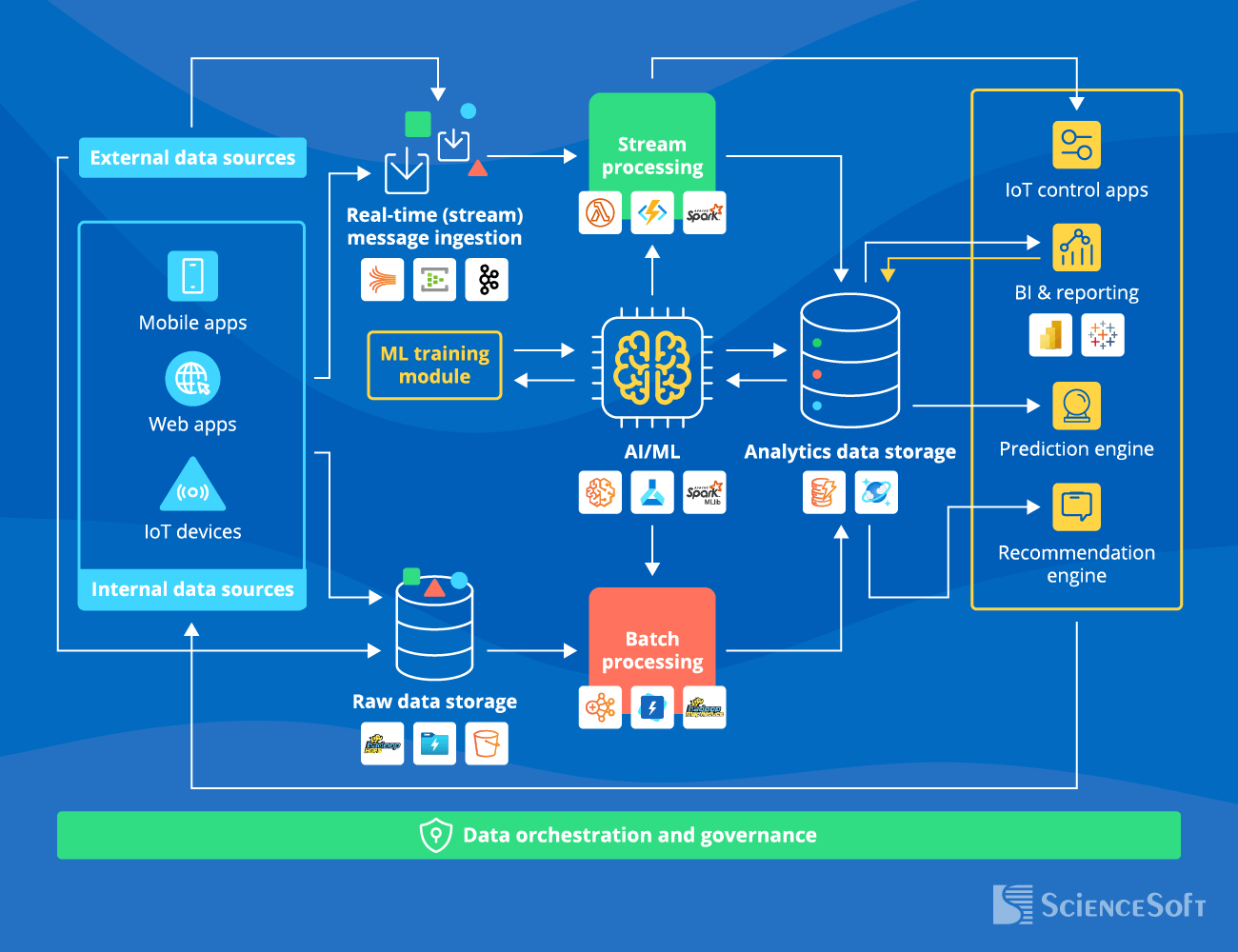Real-Time Big Data Analytics
Architecture, Market, Costs
In big data since 2013, ScienceSoft helps companies across 30+ industries build scalable, high-performing big data solutions that deliver prompt insights and automate business operations with the help of real-time analytics.
Real-Time Big Data Analytics: Market Stats and Importance for Business Performance
The global big data and analytics market is expected to reach $924 billion by 2032, growing at a CAGR of 13% during the forecasted period. The major market drivers include the need for real-time customer management insights and the increasing adoption of machine learning and AI. The industries that are expected to gain maximum revenue share from implementing the technology include BFSI, healthcare, automotive, telecoms, media, and retail.
According to the Harvard Business Review survey on enterprise data and analytics strategies, 76% of organizations say that real-time data analytics is important for business performance. 80% of leaders (organizations that have mature data analytics processes) state that the importance of real-time data analytics is increasing. The survey features responses from 336 organizations across multiple industries, including financial services, healthcare, technology, and manufacturing.
High-Level Architecture of a Real-Time Big Data Analytics Solution
Real-time big data analytics is a way to ensure instant responses to high-velocity, multi-source data. Below, ScienceSoft's data engineers outline the description of key architecture blocks and data flows for a real-time big data analytics solution.

The data sources for a real-time big data analytics solution may include web and mobile user apps, IoT devices (e.g., sensors, wearables, actuators), and external systems (e.g., stock markets, social media platforms, weather information systems).
In most cases, a solution for real-time big data analytics would feature two layers for real-time (stream) and batch big data processing.
Real-time layer
- The real-time message ingestion engine receives the latest data and sends it for processing.
- The stream processing and analytics block ensures low-latency response to events and real-time analytics insights (e.g., personalized cross-selling recommendations, alerts on patients’ abnormal vitals).
Batch layer
- The raw data storage (a.k.a. data lake) captures data in its initial format (structured, unstructured, or semi-structured).
- The batch processing block filters, cleans, aggregates, and otherwise prepares data for analytics according to the established schedule (e.g., every 2 hours, every 24 hours, every week).
The analytics data storage (a data warehouse (DWH) or a big data database) stores unified views of the data generated by stream and batch processing blocks in a highly structured format relevant to the chosen data model. The insights are served to BI software and back-office systems. Business users can also perform analysis and exploration of the data in the DWH via ad hoc queries.
The machine learning or artificial intelligence (ML/AI) engine is an optional block that enables advanced real-time analytics (e.g., dynamic pricing in ecommerce, predictive maintenance in manufacturing, fraud detection in finance). The ML training module continuously improves the AI engine's accuracy based on historical data.
The data orchestration and governance system automates data cleansing, transformation, and other recurrent data processing actions. It also ensures quality, security, and regulatory compliance of data throughout its lifecycle.
Why pair real-time analytics with historical data views?
The main goal of real-time analytics is to act on new input as soon as it arrives. We aim to process vast volumes of data from multiple sources and send back relevant responses within seconds. But how do you keep your real-time responses relevant for years if the data you receive constantly changes?
Real-time analytics doesn't work alone: historical analytics complements it by providing valuable insights for improving output over time. For instance, if you want to prevent fraudulent financial transactions, real-time analytics helps detect and stop fraud as it happens, while historical data helps AI models learn and recognize fraud patterns better over time. That’s why effective big data architectures incorporate both real-time and historical data processing to ensure high analytics accuracy even as the data landscape evolves and unseen scenarios emerge.
ScienceSoft's Expertise to Drive Your Big Data Analytics Initiative
- Since 1989 in data analytics, software engineering, and AI.
- Since 2003 in big data consulting and end-to-end big data implementation.
- A team of business analysts, solution architects, and data engineers with 7–20 years of experience.
- Practical experience in 30+ domains, including healthcare, banking, lending, investment, insurance, retail, ecommerce, manufacturing, logistics, energy, telecoms, and more.
- In-house compliance experts proficient in GDPR, HIPAA, PCI DSS, SOC 1, SOC 2, and other global and local regulations.
- ISO 9001 and ISO 27001-certified to guarantee top service quality and complete security of our clients' data.
- Established practices for scope estimation, risk mitigation, change request management, and other project management aspects.
Our awards, certifications, and partnerships
Fueling Financial Growth: The Game-Changing Benefit of Real-Time Big Data Analytics
9 out of 10 organizations globally have seen revenues and profitability grow over the last 12 months as a direct result of investing in their information management systems and strategies, averaging $1.9 billion in revenue growth per organization.
Iron Mountain, in partnership with FT Longitude.

The cost of implementing a real-time big data analytics solution may vary from $200,000 to $1,000,000+, depending on the solution's complexity. Use our online calculator to get a ballpark estimate for your case. It's free and non-binding.
Get a ballpark cost estimate for your real-time big data analytics solution.













